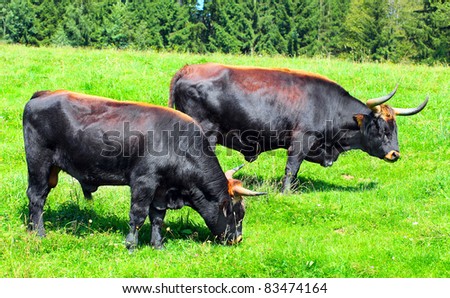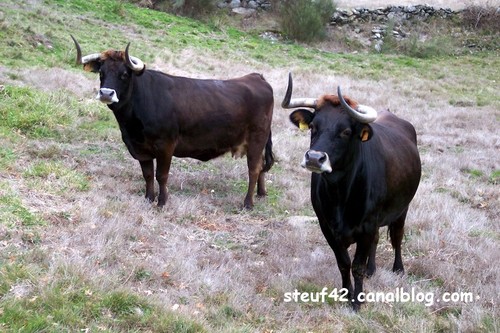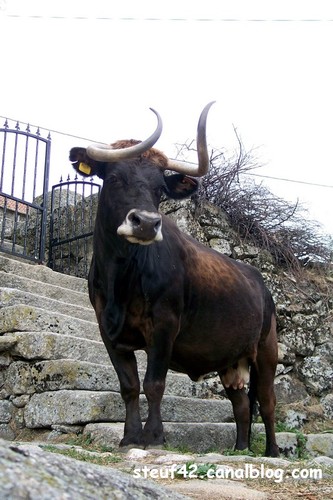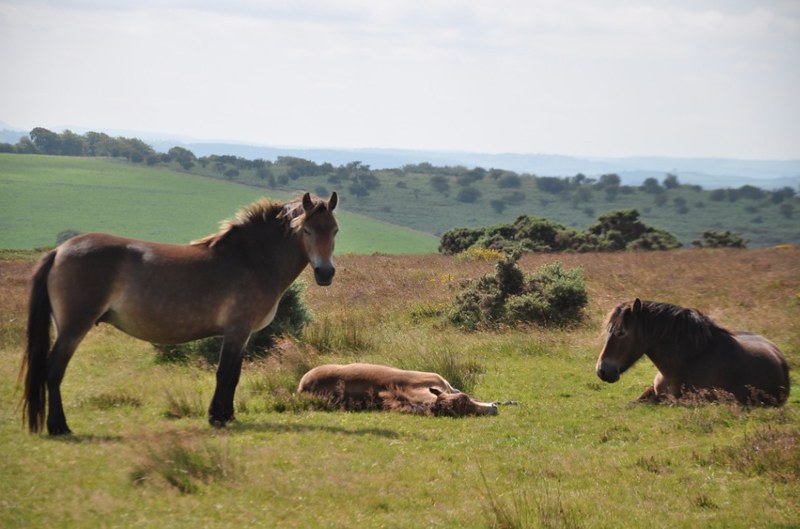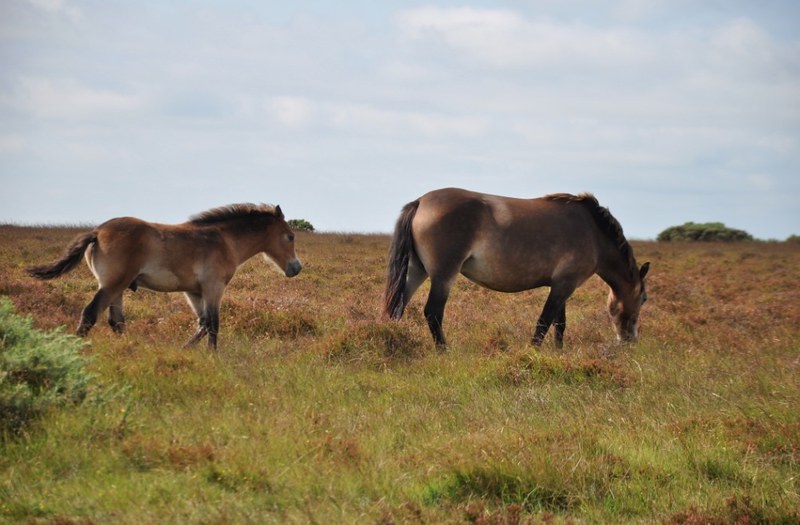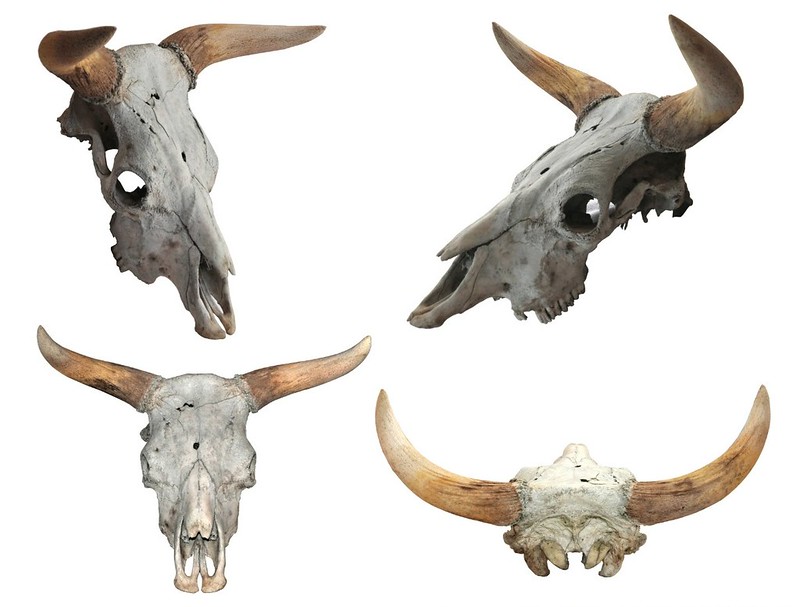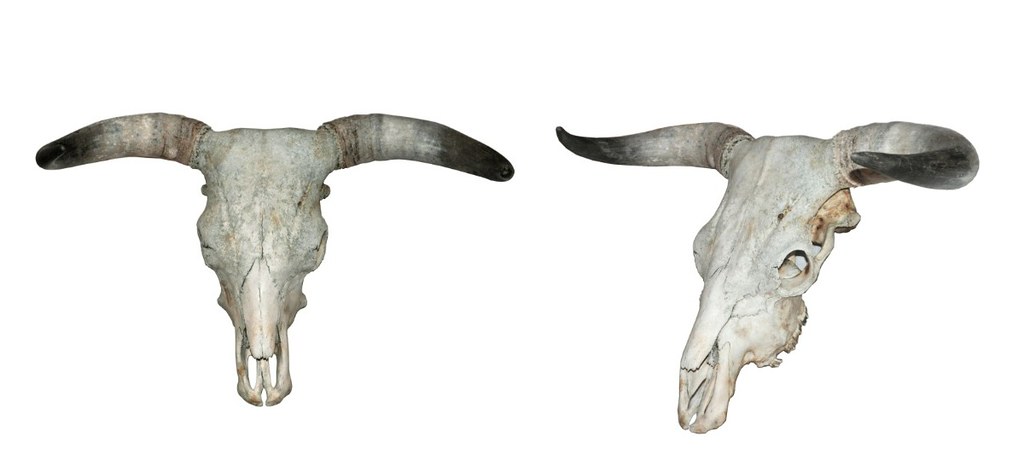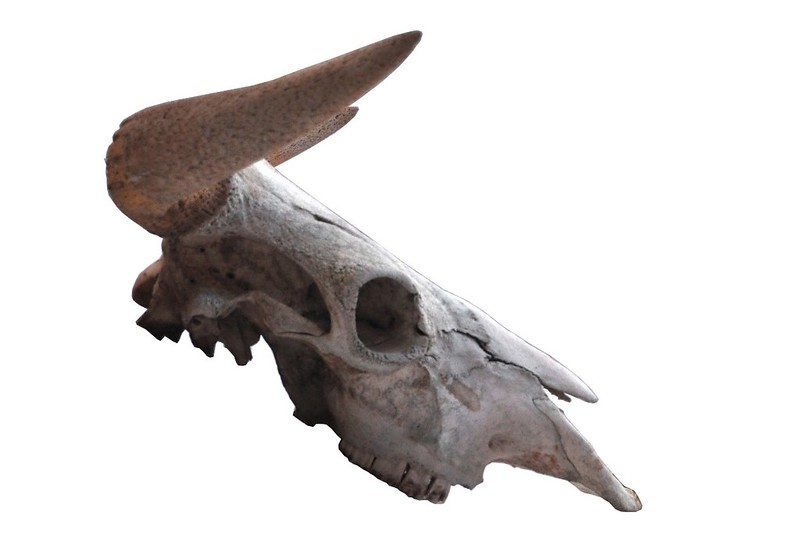The Sorraia
is one of those horse breeds of which some of its advocates claim it is a
remnant of a special wild horse population. According to them, the Sorraia
descends from supposedly wild horses spotted in the 1920s in a rural region in
Portugal, is phenotypically identical with a local wild horse type and
genetically similar to the Polish Konik and the Przewalski, endorsing its
status as a wild horse. With this post I try to give an overview over which arguments
supporting a special status for the Sorraia among other Iberian horse breeds are
verifiable, and what seems to be a colourful or wishful interpretation based on
my research for this post.
I want to
note that all this is my personal interpretation of data that was available for
me, if anyone has additional material or disagrees with my reasoning for good
reasons, I would like to read about it.
Breed history
First of
all, the Sorraia does not descend from any members of that one free-ranging horse
herd spotted by Ruy d’Andrade as he was unable to find them again. The Sorraia
actually descends from farm horses he thought to resemble those horses which he
collected for a breeding program in 1937. All Sorraia descend from four
stallions and seven mares of local farm horses, to which a Criollo stallion was
added later on.
There are
no reports of a feral horse population resembling those spotted by d’Andrade,
not even in C. H. Smith’s extremely comprehensive work The Natural History of Horses with Memoir of Gesner. D’Andrade is
the only person who saw them, and he saw them only once. I think it is much
more likely that he saw just a herd of escaped local farm horses, rather than a
population of free-ranging horses that remained undetected for decades or
centuries, were spotted by one man and disappeared into the void again. The
only references claiming there was an existence of these free-roaming horses
prior to d’Andrade’s encounter that I know of is either d’Andrade himself or
Hardy Oelke (who is one of the main contemporary Sorraia advocates), so I don’t know of a neutral reference. Sorraia
fanciers also claim that the so-called “zebro” (“encebro” in Spain) was a wild
Sorraia-type horse that disappeared in historic times. The Zebro was in fact more
likely an Iberian wild ass, a late-surviving strain of E. hydruntinus [1] or maybe a population of feral donkeys (their
wild nature is no argument against that, as feral animals do in fact re-develop
such wild traits). The European wild ass survived the longest on the Iberian
Peninsular, the last of these Zebros survived into the 16th century
in a game reserve in Murcia [1].
As you see,
the modern Sorraia is not older than 80 years, and neither does descend from a
wild or feral horse population but from local farm horses (just like the Konik,
by the way). Nevertheless, there is still the possibility that these farm horses
may have been genetically influenced by surrounding wild horses, so let’s have
a look at what genetic studies say about this horse breed so far.
Genetics
There is
some debate on whether the Sorraia is the ancestor of other, similar
Iberian-based horse breeds like the Lusitano or various Mustang lineages. This
is in fact not really relevant for the question stated in the headline of this
post; domestic breeds do give rise to other breeds, that does not place them
closer to their wild type. But since the population that is called Sorraia
originated when d’Andrade started his breeding programme in 1937, it is
chronologically not possible that the modern Sorraia gave rise to similar
Mustangs and the Lusitano, though I think its possible that they derive from a
common stock, as genetic similarities between the Sorraia and the Lusitano[2,3,4]
and phenotypic match with some Mustangs (f.e. Kiger) suggest. It is not
relevant for the wild horse debate anyway.
If the
Sorraia is a true wild horse, or at least strongly wild horse-influenced as advocates
claim, there should be a clear genetic indication for it. A connection with the
Konik, Mongolian and Przewalski horse was suggested in Jansen et al. 2002, but
later studies found the Sorraia to be more or less closely related to other
Iberian horses [3,4,5,6]. Luis et al.
2007 write: “Because of its low
variability, the Sorraia usually separated from the other [Iberian] breeds when
only one type of marker was used, seen also in […]. However, when we used all
three types of markers the Sorraia clustered with the other Iberian and Iberian
influenced-breeds […] However, new results from mtDNA analysis revealed a lost
haplotype in the Sorraia breed, which is included in the mtDNA haplogroup
recognized for heaving high frequency in Iberian horses, and the result
obtained here indicate closeness of the Sorraia with the other Iberian breeds,
which fits historical documentation.”[3] Lira et al. 2009 [5] compared
mitochondrial haplotypes of Iberian horses with those of ancient domestic and
wild horses from the Neolithic to the Bronze age and Middle age. They find no
relationship between the Sorraia and the ancient samples and conclude: “Lastly, our data do not support the Sorraia
horses as a primitive predomestic lineage, in contrast to a previous claim
(d’Andrade 1945).” The only similarity of the Sorraia with an ancient
sample is with one that is from the middle ages, what does not implicate the
Sorraia is an ancient, isolated breed. They consider the introgression of local
wild mares for all Iberian horses is possible, without giving the Sorraia a
special status.
Sorraia
advocates argue that the wild horse samples are too small and the genetic
diversity in Sorraia too limited to give an accurate clue about its relation to
predomestic horses. However, if the Sorraia is truly a remnant of the wildtype
of Equus ferus ferus, then it there
should be at least some genetic markers totally unique to the Sorraia – unless
domestic introgression and genetic bottlenecks purged them out (if that’s the
case, it is the question if it still can be considered a representative of the
wildtype then). Advocates of the breed argue that absence of evidence is not
evidence of absence, and that is true. But it is no good basis for assuming
presence either.
Phenotype
Pleistocene
horses portrayed in southern European cave paintings are used as a comparison
for the Sorraia, and the fact that these painted horses show leg and shoulder
stripes is used as an argument to support the primitive nature of the Sorraia.
But first of all, keep in mind that the end of the glacial brought a dramatic
shift in the range of the Eurasian mammal fauna and terrestrial biomes, and the
Pleistocene horse types probably represented a type different from that
inhabiting Holocene Iberia. In my personal opinion, it is likely that some of
these paintings might represent members of the przewalskii subspecies with standing manes rather than ferus with falling manes. But if we are
willing to use these paintings as a reference, what do they tell us? That wild
horses had striped legs and shoulders to a certain degree, what is typical of
many dun horses and therefore no argument in favour of any breed.
The Sorraia
is considered a primitive horse particularly because of its coat colour. It is
predominantly grulla-coloured, and grulla is often considered the standard
colour of western wild horses (although genetic data suggests that a large
portion was coloured bay/bay dun [8,9] and grulla is only one of the colours
mentioned for historic wild horses). Black dun has many different shadings,
varying from light grayish, dark gray to yellowish to almost optically brown.
Some Sorraia apparently also show a bay dun colour (see below). Bay dun and black dun are
wildtype colours, and any domestic mutations present in the breed could be
explained by domestic influence if we assume the Sorraia is a wild or ancient
horse, so the coat colour does not contract this hypothesis. I have to note two
things though: 1. the striping of the Sorraia isn’t as exceptional as often
stated, stripes are part of wildtype colour + dun expressions and shown by
other grulla horses, like the Konik or Hucule (considering that the stripes
were regarded as a trademark of the breed right from the beginning, it is also
possible that the breeders selected for prominent striping). The there are no
photos supporting the claim that the stripes in Sorraia were more prominent in
the past. 2. prominent stripes are not the unmistakeable indication of European
wild horses as one might think because of the seductively strong striping of
the African ass and, obviously, zebras. In fact, historic references for wild
or free-ranging horses don’t mention them that often, while the dorsal stripe
is nearly always remarked. Also in the Przewalski’s horse the stripes are not
that prominent (anymore?).
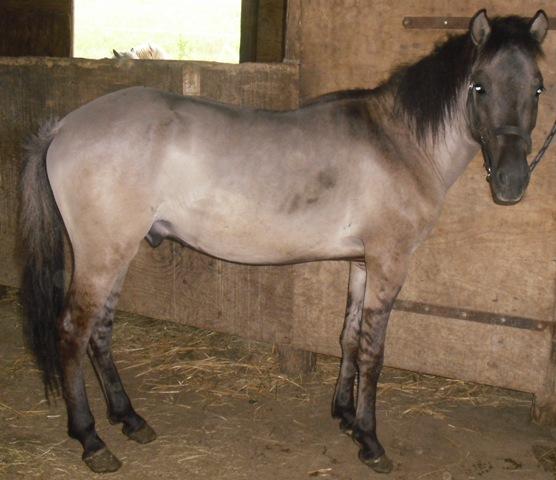 |
| Striped black dun Hucul, there are even more strongly striped Hucul |
 |
| This Sorraia seems to be bay dun ©Lynne Gerard |
The optic
similarity with the Konik, a primitive horse breed from eastern Europe and thus
far removed from the Sorraia, provokes the assumption that their phenotypic
traits are inherited from a common ancestor since genetic exchange seems very
unlikely. But in fact this similarity is grounded almost exclusively on the
coat colour features (as primitive Koniks are smaller and more sturdy in build),
which are regulated by only two loci (Agouti and Dun) since both breeds are
non-sorrel horses. Bicoloured manes and tails, dorsal and leg stripes are part
of the expression of black dun (=grulla). Black dun colours are not rare in
rural horses and ponies, and it is one of the wildtype colours of Equus ferus; thus its presence in two
compared horse breeds is not a surprise and also no indication of a common,
predomestic ancestry.
While the coat
colour is no argument against a status of the Sorraia as an ancient horse,
their body conformation seems problematic. The Sorraia is a quite large
(140-150 cm), lightly built horse with a proportionally small and slender head.
Historic references for central and eastern European, Russian and even western
European wild horses describe a horse type with a body conformation that is
quite the opposite – small, stocky, with strong legs and a proportionally large
and robust head. However, Sorraia fanciers argue that the Sorraia is a remnant
of a specialized Iberian subtype of the wild horse, and there are no historic
references describing wild horses from the western Iberian peninsular as far as
I know, so that this is not necessarily contradicted. Genetic data suggests
that the extinct wild horse population was separated into two main populations:
one huge, panmictic population eastern to the Pyrenees inhabiting the Eurasian
steppe, and one smaller population western to the Pyrenees inhabiting the
Iberian peninsular [10]. So the hypothesis there was an Iberian wild horse that
slenderer and taller than other members of Equus
ferus seems at least possible. But is there evidence for it? This is hard
to tell because it is difficult to tell wild horses apart from domestic horses
in the subfossil record of the late Holocene without genetic testing. I know
that d’Andrade did measurements with skeletal elements of the Sorraia and
supposed wild horses, and I do not dispute his professional competence, but I
am not sure if it was possible to safely distinguish between domestic and wild
horses back this time (except for some unambiguous cranial features, such as
enlarged eyes and a reduced brain case). Furthermore, the Sorraia remains he
worked with were prior to the bottleneck event, so modern Sorraia might display
different features due to genetic drift. I know of Ebhardt’s division of 4
predomestic subtypes of Equus ferus that includes one type resembling the
Sorraia, but it seems that there is low scientific support for it in modern
scientific literature (although it is popular among hippologists). I haven’t
seen any recent studies using or referring to it. Of course it is likely that
different environments had a different impact on wild Equus ferus over its large geographic range, but the proposal of
regionally differentiated body conformations should be grounded on a osteologic
basis or on reports of people having seen these animals in flesh. Of course it
is possible that the western wild horse was regionally differentiated, but
other large herbivores with a large geographic range such as Red deer or moose
don’t display any radical differences in body conformation when comparing their
various subspecies (island dwarfism in case of Red deer on Sicily is another
story), so it does not imply it.
Sorraia.org
claims that the Danish wild horse skeleton from 11.100 years BP is identical in
proportions and skull shape to Sorraias. I do not really see that, it would be
more conclusive for me if it would be a member of the przewalskii clade and its
head is clearly more robust (sorraia.org provides a superimposition with a
Sorraia skull photo from d’Andrades work, but this historic skull hardly fits
modern Sorraia’s heads because the lower jaw is more robust; perhaps an effect
of the genetic bottleneck?). I will do a life reconstruction of that skeleton
soon to get a better idea of what it might have looked like in life. Nevertheless, not all Sorraia have a gracile head. Looking at
this dental, claimed by sorraia.org to be an example of a gracile-jawed wild
horse remain, and comparing it with an Exmoor pony skull from Sue Baker’s book,
it appears to me that this wild horse had a skull only insignificantly longer
(=more gracile) than the Exmoor. To affirm the question if there are definite
wild horse remains that endorse the hypothesis that there were predomestic
horses that had a body conformation similar to the Sorraia, a new osteometric
study comparing a representative sample of confirmed wild horse and Sorraia
skeletons would be needed. Sorraia advocates sometimes also refer to Equus stenonis, but this is a huge and
most likely incorrect stretch, as E.
stenonis was only distantly related to E.
ferus and disappeared in the late Pliocene. Furthermore, their hypergracile
skulls have a concave profile, the opposite of what we see in the Sorraia.
 |
| Skull of a Sorraia Mustang mare ©Lynne Gerard |
 |
| Skull of a Sorraia Mustang stallion ©Lynne Gerard |
While
looking for good Sorraia skull photos to compare them with wild horse skulls, I
stumbled across something interesting. Lynne Gerard published photos of skulls
of two of her Sorraia Mustang individuals, a stallion and a mare, on her blog. While
neither of the photos shows a lower jaw in a useful lateral perspective, we are
able to see that the size of the orbital openings is well larger than in wild
horse skulls (I am using the Danish specimen, and in the lack of other useful
European species, also American wild horses as a reference, which where
probably conspecific). The increase of the eye size, as well as a reduction of
brain size, is a typical artefact of domestication, visible in virtually any
domesticated larger mammal, and shared by other domestic horses – even
primitive ones like the Exmoor pony.
Conclusion
I want to
make clear that I am not biased against the Sorraia. The idea that Iberia had a
unique subtype of the European wild horse differing in having a taller, much
slenderer body than other wild horses is exciting, but I think the evidence for
that is rather thin. And if there was, I do not think the Sorraia would be a predomestic
remnant population of this type, but more likely a domestic breed with
introgression of these horses. Nevertheless, I think that the western Iberian
wild horse was not drastically different from the wild horses formerly
inhabiting the Pyrenees and Northern Spain as described by C. H. Smith, unless
there is there is evidence for the contrary – I think this is the most
parsimonious and most likely assumption.
An osteometric evaluation of confirmed wild horse remains from various
places of Europe would be very helpful to gain information about the appearance
of Holocene wild horses and regional diversification.
The
hypothesis that the Zebro was a Sorraia-type horse rather than a wild for feral
ass seems far-fetched as well. If this was not the case, then I assume that
there was no feral population with a long history in the area d’Andrade spotted
those nebulous horse herd, as there are no other references to it. Most likely
he saw an abandoned farm horse herd. The Sorraia itself is not older than 80
years, since it was created in the year 1937 by collecting local farm horses
resembling those spotted by d’Andrade. Genetically, there is no solid evidence
for the Sorraia having a special status on the domestic equine tree. Absence of
evidence is no evidence of absence, but proposals like the Sorraia being a
predomestic horse should have a more solid basis than this.
It seems
that the Sorraia breed is “just” a domestic horse breed, albeit a hardy and
robust landrace. In my personal opinion, the Sorraia and Lustano as much as
similar mustangs like Kiger, Sulphur and Pryor might all derive from a historic
domestic breed/type of horses with an appearance very similar to their modern
counterparts, what is inferred by their very similar phenotype and also genetic
similarities.
Literature
[1] Bunzel-Drüke, Finck, Kämmer, Luick,
Reisinger, Riecken, Riedl, Scharf & Zimball: Wilde Weiden:
Praxisleitfaden für Ganzjahresbeweidung in Naturschutz und
Landschaftsentwicklung. Arbeitsgemeinschaft Biologischer Umweltschutz
[2] Jansen
et al.: Mitochondrial DNA and the origins of the domestic horse. 2002
[3] Luis et
al.: Genetic diversity and relationships of Portuguese and other horse breeds
based on protein and microsatellite loci variation. 2007
[4] Luis et
al.: A lost Sorraia maternal lineage found in the
Lusitano horse breed. 2006
[5] Lira et
al.: Ancient DNA reveals traces of Iberian Neolithic and Bronze Age lineages in
modern Iberian horses. 2009
[6] Royo et
al.: The origins of Iberian horses assessed via mitochondrial DNA. 2005
[7] Cieslak
et al.: Origin and History of Mitochondrial DNA lineages in Domestic horses.
2010
[8] Ludwig
et al.: Coat colour variation at the beginning of horse domestication. 2009
[9] Pruvost
et al.: Genotypes of predomstic horses match phenotypes painted in paleolithic
works of cave art. 2011
[10]Cieslak
et al.: Coat colours and mitochondrial lineages of ancient horses to document
domestication. 2011

